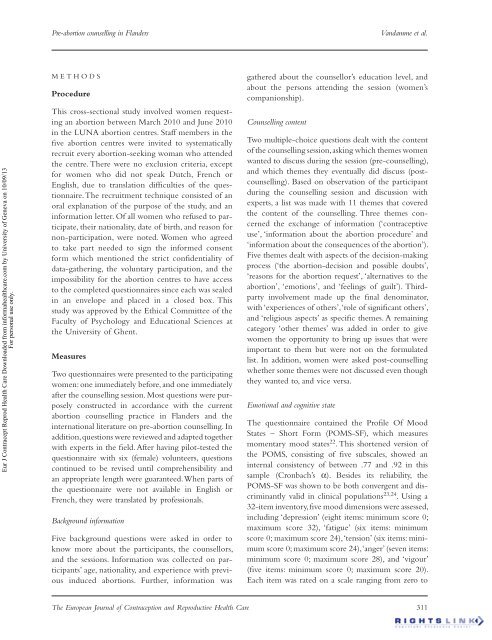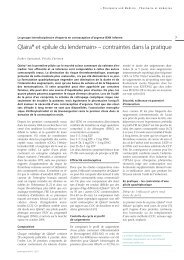Pre-abortion counselling from women's point of view - artcoss
Pre-abortion counselling from women's point of view - artcoss
Pre-abortion counselling from women's point of view - artcoss
Create successful ePaper yourself
Turn your PDF publications into a flip-book with our unique Google optimized e-Paper software.
<strong>Pre</strong>-<strong>abortion</strong> <strong>counselling</strong> in FlandersVandamme et al.Eur J Contracept Reprod Health Care Downloaded <strong>from</strong> informahealthcare.com by University <strong>of</strong> Geneva on 10/09/13For personal use only.METHODSProcedureThis cross-sectional study involved women requestingan <strong>abortion</strong> between March 2010 and June 2010in the LUNA <strong>abortion</strong> centres. Staff members in thefive <strong>abortion</strong> centres were invited to systematicallyrecruit every <strong>abortion</strong>-seeking woman who attendedthe centre. There were no exclusion criteria, exceptfor women who did not speak Dutch, French orEnglish, due to translation difficulties <strong>of</strong> the questionnaire.The recruitment technique consisted <strong>of</strong> anoral explanation <strong>of</strong> the purpose <strong>of</strong> the study, and aninformation letter. Of all women who refused to participate,their nationality, date <strong>of</strong> birth, and reason fornon-participation, were noted. Women who agreedto take part needed to sign the informed consentform which mentioned the strict confidentiality <strong>of</strong>data-gathering, the voluntary participation, and theimpossibility for the <strong>abortion</strong> centres to have accessto the completed questionnaires since each was sealedin an envelope and placed in a closed box. Thisstudy was approved by the Ethical Committee <strong>of</strong> theFaculty <strong>of</strong> Psychology and Educational Sciences atthe University <strong>of</strong> Ghent.MeasuresTwo questionnaires were presented to the participatingwomen: one immediately before, and one immediatelyafter the <strong>counselling</strong> session. Most questions were purposelyconstructed in accordance with the current<strong>abortion</strong> <strong>counselling</strong> practice in Flanders and theinternational literature on pre-<strong>abortion</strong> <strong>counselling</strong>. Inaddition, questions were re<strong>view</strong>ed and adapted togetherwith experts in the field. After having pilot-tested thequestionnaire with six (female) volunteers, questionscontinued to be revised until comprehensibility andan appropriate length were guaranteed. When parts <strong>of</strong>the questionnaire were not available in English orFrench, they were translated by pr<strong>of</strong>essionals.Background informationFive background questions were asked in order toknow more about the participants, the counsellors,and the sessions. Information was collected on participants’ age, nationality, and experience with previousinduced <strong>abortion</strong>s. Further, information wasgathered about the counsellor ’ s education level, andabout the persons attending the session (women ’ scompanionship).Counselling contentTwo multiple-choice questions dealt with the content<strong>of</strong> the <strong>counselling</strong> session, asking which themes womenwanted to discuss during the session (pre-<strong>counselling</strong>),and which themes they eventually did discuss (post<strong>counselling</strong>).Based on observation <strong>of</strong> the participantduring the <strong>counselling</strong> session and discussion withexperts, a list was made with 11 themes that coveredthe content <strong>of</strong> the <strong>counselling</strong>. Three themes concernedthe exchange <strong>of</strong> information ( ‘ contraceptiveuse ’ , ‘ information about the <strong>abortion</strong> procedure ’ and‘ information about the consequences <strong>of</strong> the <strong>abortion</strong> ’ ).Five themes dealt with aspects <strong>of</strong> the decision-makingprocess ( ‘ the <strong>abortion</strong>-decision and possible doubts ’ ,‘ reasons for the <strong>abortion</strong> request ’ , ‘ alternatives to the<strong>abortion</strong> ’ , ‘ emotions ’ , and ‘ feelings <strong>of</strong> guilt ’ ). Thirdpartyinvolvement made up the final denominator,with ‘ experiences <strong>of</strong> others ’ , ‘ role <strong>of</strong> significant others ’ ,and ‘ religious aspects ’ as specific themes. A remainingcategory ‘ other themes ’ was added in order to givewomen the opportunity to bring up issues that wereimportant to them but were not on the formulatedlist. In addition, women were asked post-<strong>counselling</strong>whether some themes were not discussed even thoughthey wanted to, and vice versa.Emotional and cognitive stateThe questionnaire contained the Pr<strong>of</strong>ile Of MoodStates – Short Form (POMS-SF), which measuresmomentary mood states 22 . This shortened version <strong>of</strong>the POMS, consisting <strong>of</strong> five subscales, showed aninternal consistency <strong>of</strong> between .77 and .92 in thissample (Cronbach ’ s α ). Besides its reliability, thePOMS-SF was shown to be both convergent and discriminantlyvalid in clinical populations 23,24 . Using a32-item inventory, five mood dimensions were assessed,including ‘ depression ’ (eight items: minimum score 0;maximum score 32), ‘ fatigue ’ (six items: minimumscore 0; maximum score 24), ‘ tension ’ (six items: minimumscore 0; maximum score 24), ‘ anger ’ (seven items:minimum score 0; maximum score 28), and ‘ vigour ’(five items: minimum score 0; maximum score 20).Each item was rated on a scale ranging <strong>from</strong> zero toThe European Journal <strong>of</strong> Contraception and Reproductive Health Care 311



